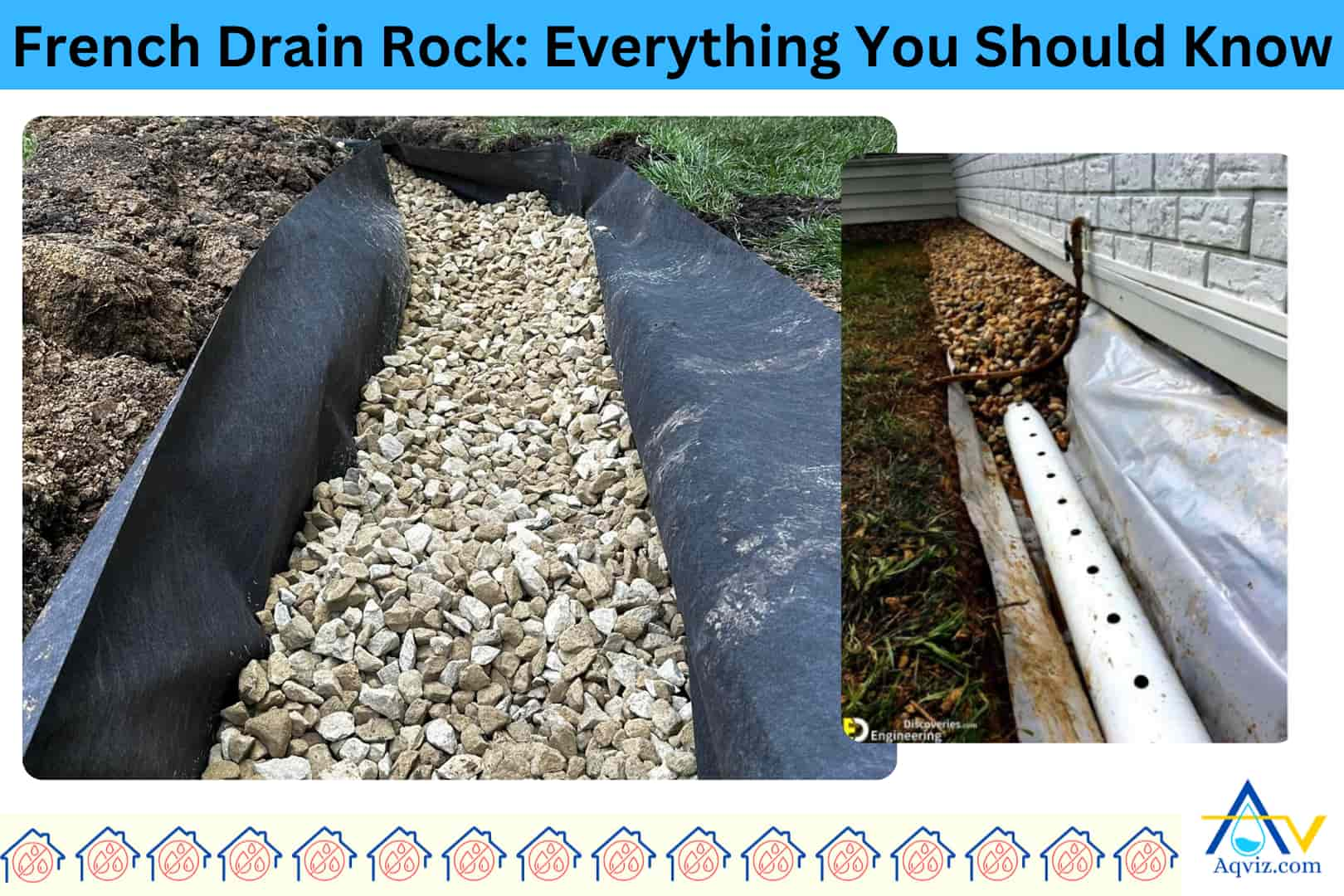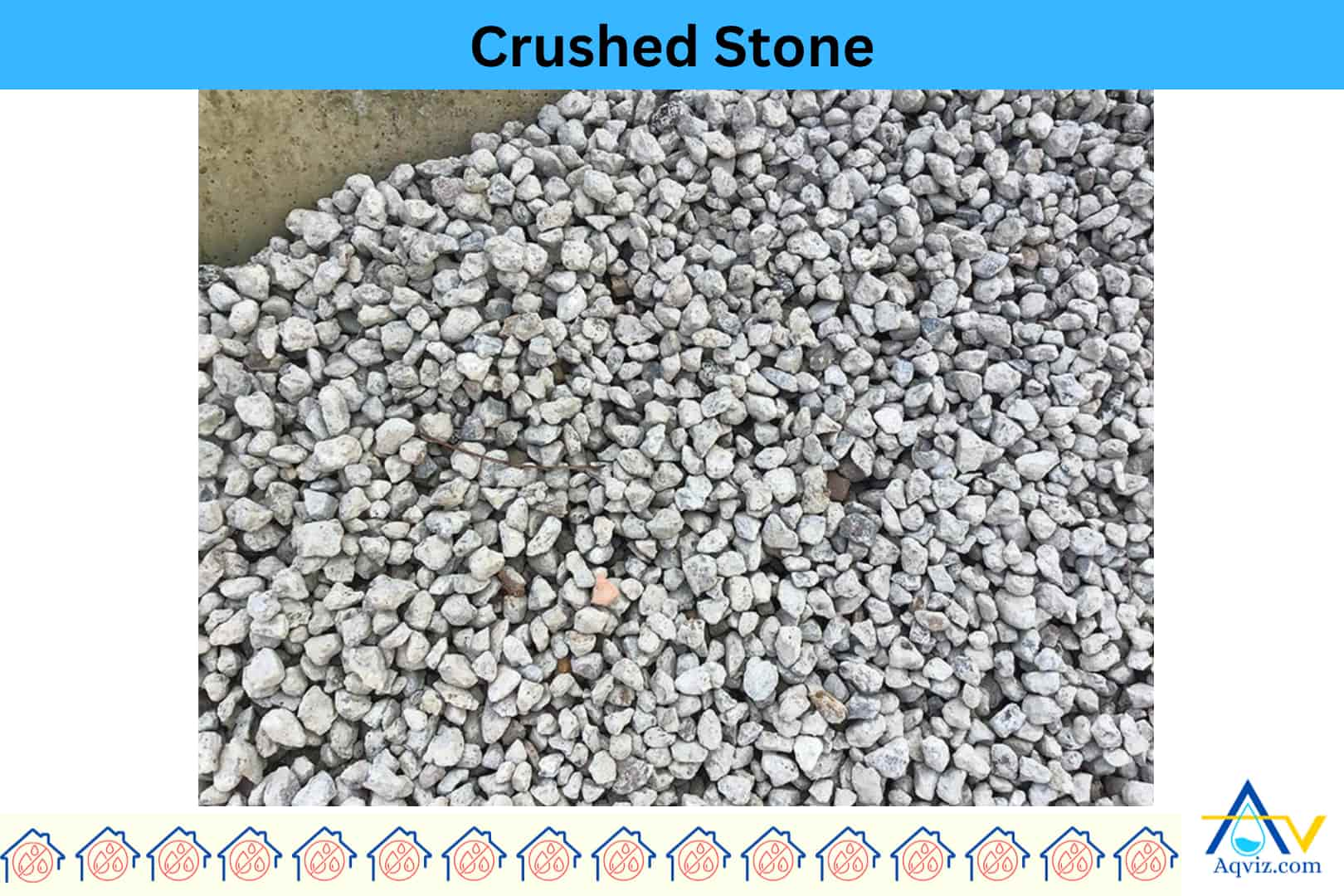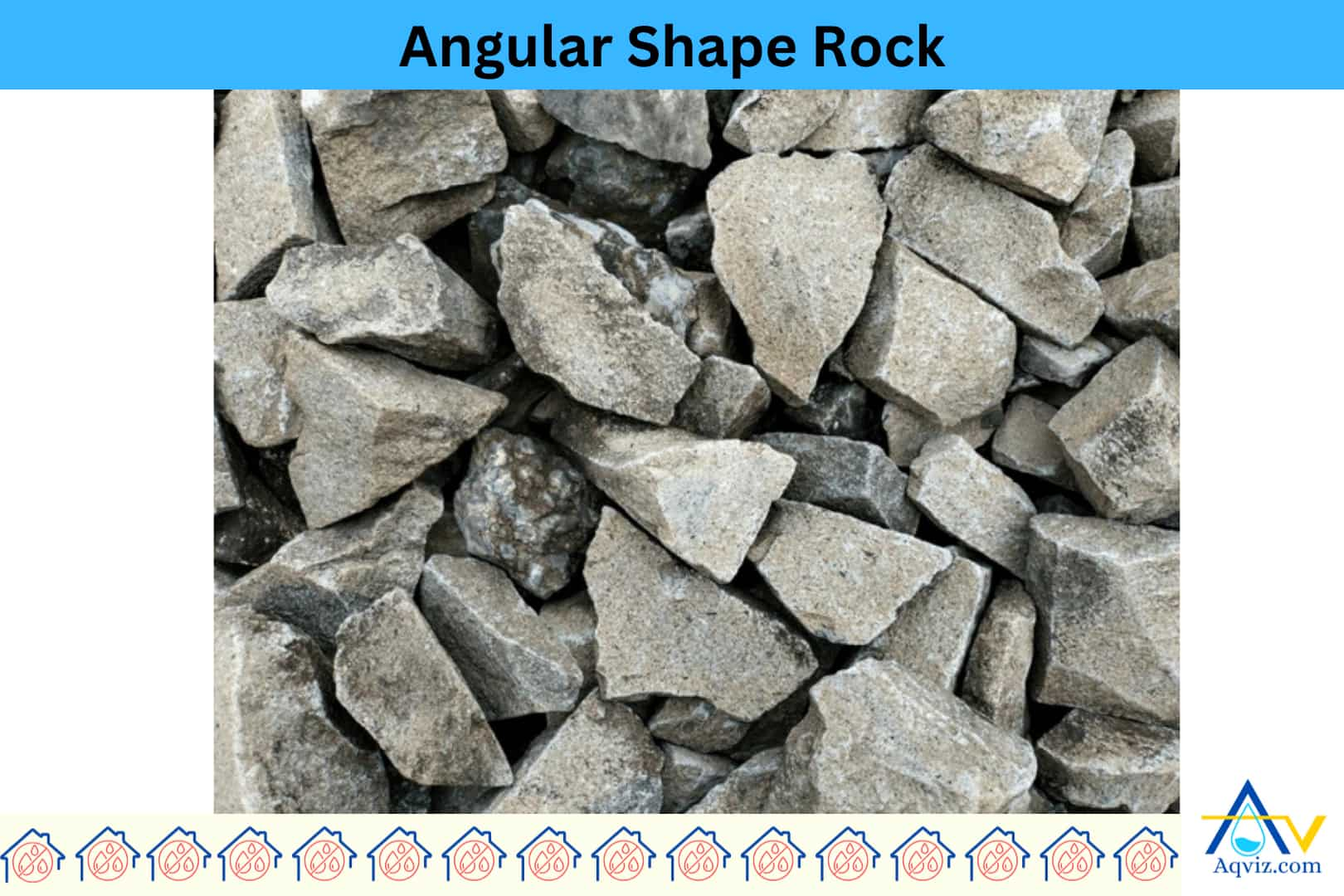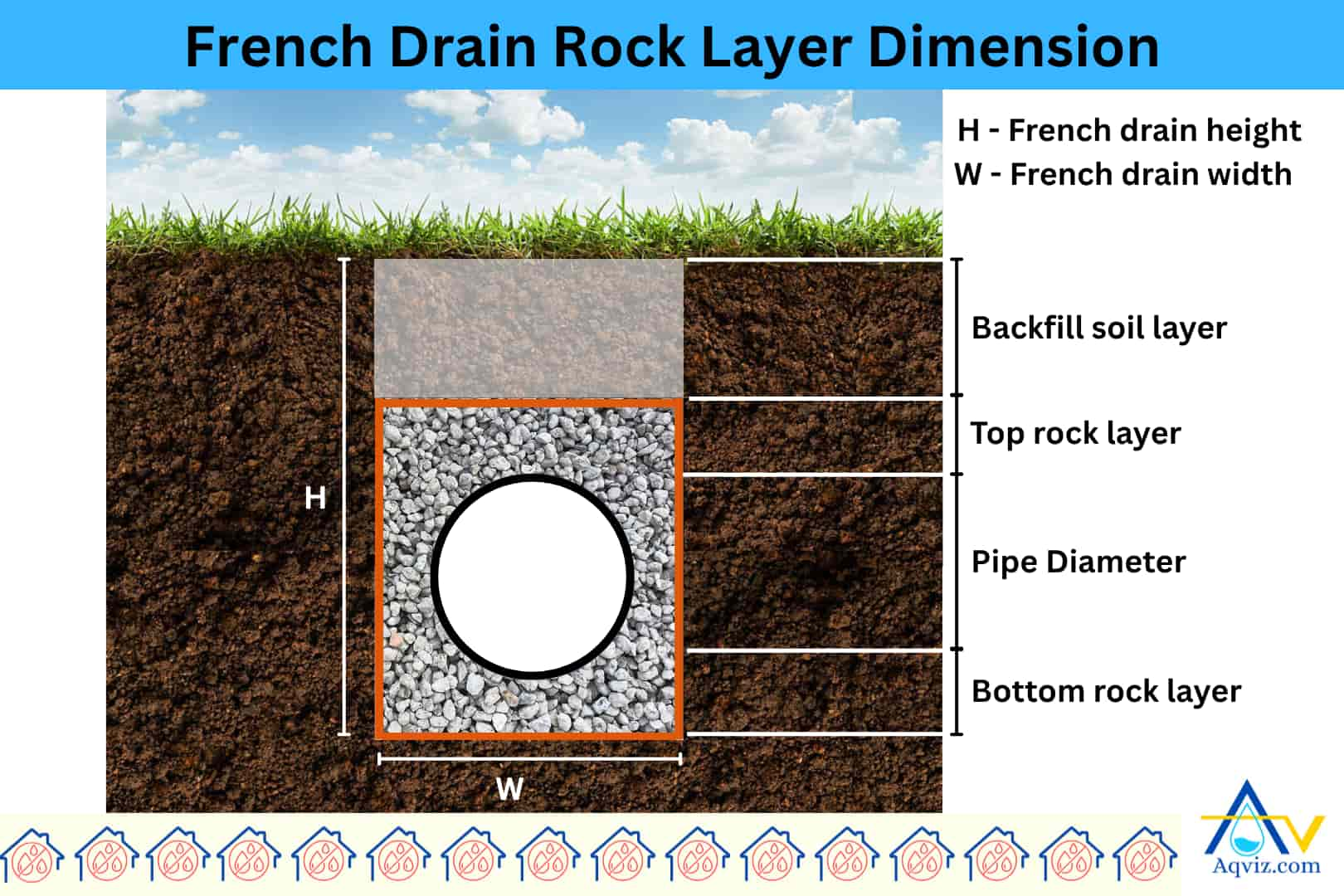French Drain Rock: Everything You Should Know

French drain rock is referred to as a layer of washed, angular gravel or crushed stone used to surround the perforated pipe in a French drain system. This rock creates a porous path that allows groundwater to flow freely into the pipe while filtering out debris and supporting proper drainage flow.
Crushed stone is the best French drain rock material due to it resistance to compaction, offering higher permeability, and providing excellent structural support. You should not use pea gravel, crushed concrete, or river rock.
When you use French drain rock, the best shape is an angular shape, and the size is 3/4 inches (19mm). You should not use rounded rocks because they compact too easily. Also, their surface is smooth, and there is limited permeability. The minimum rock size is 1/2 inch (13mm).
If you use less than that, those will compact tightly, and water will not drive into the perforated pipe. If you use rock more than 1 1/2 inches (38 mm), it creates excessively large gaps, which reduce the filtration capability and allow fine soil particles to migrate into the system.
When you install rock on the perforated pipe, you should lay 2-4 inches minimum above the pipe top. As well as you should lay a 4-6 inches (10 to 15 cm) deep rock layer. This ensures the pipe stays elevated, stable, and free from soil contact that could block the holes or cause sagging.
To calculate the French drain rock and cost, you should use the Aqviz French drain rock calculator. Our Experts have prepared this tool by considering our previous experience and practices. If you do not maintain and repair the French drain at least once per 2 years, it may become clogged and block the water flow in the drain. So Aqviz experts always recommend that you clean, repair, and maintain it properly and on time. If there is any French drain rock problem, contact Aqvz experts. We will support you anytime.
What is French Drain Rock?
French drain rock is referred to as a layer of washed, angular gravel or crushed stone used to surround the perforated pipe in a French drain system. This rock creates a porous path that allows groundwater to flow freely into the pipe while filtering out debris and supporting proper drainage flow.
The main purpose of French drain rock is to facilitate water movement, reduce soil compaction around the pipe, and prevent sediment from entering the drainage system. It also distributes the weight of the soil evenly to protect the pipe from collapse. When installed correctly, French drain rock helps manage subsurface water effectively and extends the lifespan of the entire drainage system.

What Are the Types of French Drain Rock?
French drain rock is mainly of 4 types, including crushed granite, crushed limestone, drainage gravel, and river rock (not much recommended). Each type serves the same function, promoting water flow and preventing clogs in the French drain.
What Is the Best Rock for French Drains?
The best rock for French drains is washed, angular crushed stone with a size of 3/4 inch (19 mm). This rock type offers the ideal balance of drainage performance, structural support, and long-term durability. Its sharp, interlocking edges prevent movement, resist compaction, and maintain open voids that allow water to flow efficiently toward the perforated pipe.
Among crushed stone types, crushed granite and crushed limestone are the most effective due to their strength and stability. The ¾ inch size is large enough to prevent clogging by soil fines, yet small enough to form a tight packing structure around the pipe.
You should avoid unwashed or rounded materials like pea gravel or river rock, as they trap debris and reduce flow. For the most reliable drainage system, always use washed, angular 3/4 inch crushed rock specifically labeled for drainage applications.
You will need these materials and requirements for a French drain construction. So we highly recommend that you pay attention to this always.
Can You Use Crushed Rock for a French Drain?
Yes, you can use crushed rock for French drains, and it is one of the most recommended French drain rock materials by the experts. Crushed stone is made by mechanically breaking down larger rocks such as limestone, granite, or basalt into smaller, angular pieces. These sharp-edged fragments interlock well, creating stable voids that allow water to flow freely.
Crushed rock is ideal for French drains because it resists compaction, offers high permeability, and provides excellent structural support around the perforated pipe. Its angular shape prevents soil intrusion better than round gravel, making it less prone to clogging. You should always choose washed, 3/4 inch (19 mm) crushed stone to ensure consistent drainage performance and long-term durability.

Can You Use Pea Gravel for a French Drain?
No, you can’t use pea gravel for French drains because its rounded shape causes poor interlocking, which leads to compaction and restricted water flow over time. It also allows soil and sediment to migrate easily, increasing the risk of pipe clogging. Unlike angular crushed stone, pea gravel doesn’t provide the structural stability needed to protect the perforated pipe. For effective drainage, you should always choose washed, angular gravel that maintains open voids and supports long-term water movement.
Pea gravel is a small, smooth, naturally rounded stone typically about 3/8 inch (9.5 mm) in diameter. It is often used in landscaping for decorative purposes, walkways, and garden beds because of its smooth texture and uniform appearance.
What Rock Shape Is Good for a French Drain?
For French drains, the best rock shape is angular. Its sharp edges allow the stones to lock tightly together, which helps maintain structural stability, creates permanent air gaps for water flow, and resists shifting or settling over time.
French drain rock is available in two primary shapes: angular and rounded. Angular rock includes crushed stone, where each piece has sharp, jagged edges, while rounded rock includes materials like pea gravel and river rock, which have smooth, curved surfaces from natural weathering.
Rounded stones, on the other hand, compact too easily, reduce drainage capacity, and allow sediment to migrate, which increases the risk of clogs. You should always choose angular, washed gravel to build an effective and low-maintenance French drain system.

What is the Best Rock Size for a French Drain?
The best rock size for a French drain is 3/4 inch (19 mm) angular, washed gravel. This size provides the ideal balance between drainage efficiency, soil filtration, and pipe protection. It is large enough to prevent fine soil particles from clogging the system, yet small enough to tightly surround the perforated pipe without leaving large voids that could lead to settling.
Using ¾ inch rock ensures consistent water flow through the gravel bed and around the pipe while maintaining structural stability. Smaller stones (like 3/8 inch) compact too tightly and restrict flow, while larger stones (over 1 1/2 inches) create gaps that allow soil intrusion and reduce filtration. You should always use clean, uniformly graded 3/4 inch crushed rock for optimal French drain performance and longevity.
What Is the Minimum French Drain Rock Size?
The minimum rock size you should use for a French drain is 1/2 inch (13 mm) washed, angular gravel. This is the smallest size that still provides sufficient drainage voids, resists compaction, and prevents fine soil migration into the pipe system when used with geotextile fabric.
Using rock smaller than 1/2 inch, such as 3/8 inch pea gravel, is not recommended because it compacts too tightly, reducing water flow capacity and increasing the risk of clogging. Smaller particles also trap more silt and sediment, which shortens the lifespan of the drainage system. For reliable performance, always select washed gravel no smaller than 1/2 inch, with 3/4 inch (19 mm) being the most effective and industry-preferred size.
What is the Largest Rock Size for a French Drain?
The maximum rock size you should use for a French drain is 1 1/2 inches (38 mm) of washed, angular gravel. This size is suitable for high-volume drainage situations and still maintains good void space for water movement without allowing soil intrusion.
Using rock larger than 1 1/2 inches is not recommended because it creates excessively large gaps, which reduce the filtration capability and allow fine soil particles to migrate into the system.
Oversized rocks also provide less uniform support around the perforated pipe, increasing the risk of shifting and uneven load distribution. For most residential French drains, the ideal size remains 3/4 inch (19 mm), but if a larger size is needed, it should not exceed 1½ inches to preserve both function and longevity.
What is the Height of the French Drain Rock layer?
The Total height of the French drain rock layer should be between 12-18 inches (30-46cm). The height of the French drain rock layer should be the sum of the height above the pipe, the depth below the pipe, and the diameter of the pipe.

What Is the French Drain Rock Layer Height Above the Pipe?
The rock height in a French drain refers to the layer of gravel placed above the top of the perforated pipe, forming the drainage top surface. It provides full coverage to promote efficient water entry and flow. The minimum requirement is to extend the gravel at least 2 to 4 inches (5 to 10 cm) above the pipe’s top. It ensures that water can reach the pipe from above while preventing soil pressure from directly on the pipe.
If the gravel layer is increased beyond the minimum, it enhances drainage performance by expanding the water collection zone and allowing more surface infiltration. However, you should not overfill the trench with gravel without proper geotextile wrapping, as exposed gravel can mix with soil and lead to clogging. For best results, maintain a total gravel height of at least 6 inches (15 cm) above the pipe, and always cover it with fabric before backfilling with soil.
What Is the French Drain Rock Layer Depth Below the Pipe?
The rock depth in a French drain refers to the layer of gravel placed below the bottom of the perforated pipe, forming the drainage base. This layer provides support, stabilizes the pipe, and allows water to flow evenly into the bottom perforations.
The minimum requirement is at least 4 to 6 inches (10 to 15 cm) of washed, angular gravel beneath the pipe. This ensures the pipe stays elevated, stable, and free from soil contact that could block the holes or cause sagging.
If the rock depth is increased, it improves drainage capacity by offering more space for water collection and helps stabilize the pipe in looser or saturated soils. However, going too deep without reason can raise installation costs and may reduce the overall slope efficiency if not planned correctly. For most applications, keeping the gravel base between 6 to 12 inches (15 to 30 cm) provides the best balance of function, cost, and performance.
What is the Width of the French Drain Rock Layer?
The width of the French drain rock layer is considered the total width of the trench.
How to Calculate French Drain Rock Amount?
To calculate how much French drain rock you need , you should determine the net volume of gravel required to fill the trench around the perforated pipe. This means you should calculate the total trench volume and subtract the volume of the pipe, since it displaces some of the gravel space. This gives you an accurate estimate of the actual gravel required.
Step-by-Step Calculation for French Drain Rock
Step 1: Measure total Rock Layer dimensions:
- Length of trench (L) in feet
- Width of rock layer (W) in inches (typically 1 to 1.5 ft or 12-18 inches)
- Depth of the rock layer (D) in inches (typically 1.5 to 2 ft 12-24 inches)
Step 2: Calculate total trench volume:
Total Volume (cubic feet) = Length × Width × Depth
Step 3: Calculate pipe volume for a 4-inch pipe (0.33 ft diameter):
Pipe Volume = Length × π × (0.165 ft)² ≈ Length × 0.0856
Step 4: Subtract pipe volume from trench volume:
Net Gravel Volume = Total Trench Volume – Pipe Volume
Step 5: Convert to cubic yards:
Cubic yards = Net Gravel Volume ÷ 27
Read More: How to Install a French Drain?
What Causes Clogging of a French Drain?
If the French drain is not performed properly, it may be clogged due to below 9 reasons such as
- Fine soil infiltration into the perforated pipe
- Sediment buildup in the pipe
- Organic debris (leaves, mulch, roots) has clogged the pipe
- Improper or damaged geotextile fabric near the grain
- Use of unwashed gravel or pea gravel for the French drain
- Root intrusion into the rock layer and damage it from nearby plants or trees
- Crushed or sagging drain pipe
- Insufficient slope in the trench
- Blocked discharge outlet
Read More About: How to Unclog a French Drain?
Can I Use River Rock for French Drains?
You can use River rock for French drains. If you use it, you have to face these issues. The main issue is that river rock does not interlock like angular crushed stone. This leads to shifting, settling, and poor structural support around the perforated pipe. It also allows soil migration between the rocks due to large gaps, increasing the risk of clogs and system failure. Additionally, river rock compacts unevenly, which can disrupt the proper slope needed for gravity-based flow.
For effective and long-lasting French drain performance, you should always use washed, angular crushed stone, not smooth, round river rock.
Can I Use Lava Rock for French Drains?
You should not use lava rock for French drains. Although it is lightweight and highly porous, lava rock has several characteristics that make it unsuitable for proper drainage performance.
Lava rock is irregular in shape and very brittle, which means it can break down over time under soil pressure, leading to compaction and reduced flow capacity. Its porous texture also traps fine particles, increasing the risk of clogging the system. In addition, its lightweight nature causes it to shift or float during heavy water flow, reducing the stability around the perforated pipe.
For a reliable and durable French drain, you should use washed, angular crushed stone (3/4 inch or 19 mm) that offers strong interlocking support, proper weight, and long-term resistance to clogging.
